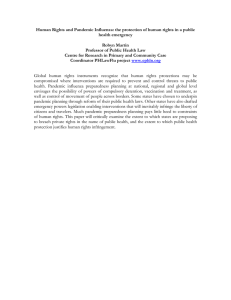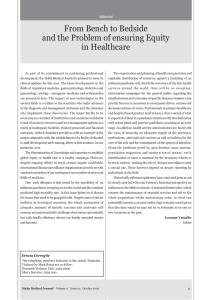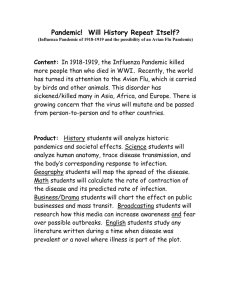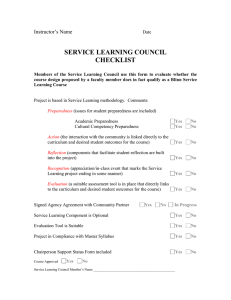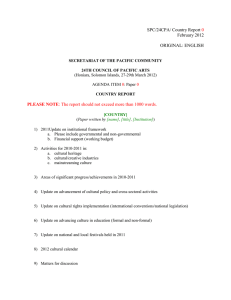PRIPP OVERVIEW
advertisement
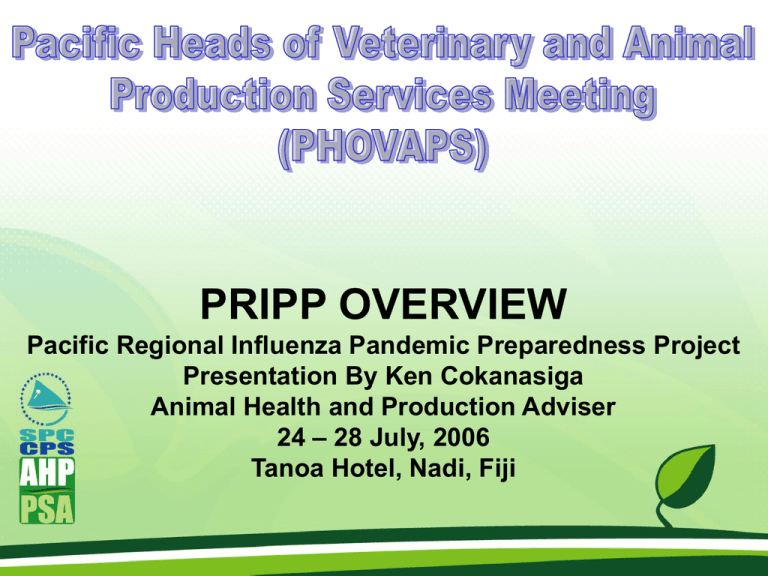
PRIPP OVERVIEW Pacific Regional Influenza Pandemic Preparedness Project Presentation By Ken Cokanasiga Animal Health and Production Adviser 24 – 28 July, 2006 Tanoa Hotel, Nadi, Fiji Introduction • The goal of the project is to prepare PICTs for emerging diseases, in particular highly pathogenic avian influenza (HPAI) and pandemic human influenza Focus • The project components reflect the three broad areas of intervention: – Preparedness and broader Emergency Plans – Surveillance and Response by Public and Animal Health Systems – Regional Coordination and Project Management PRIPP Design Steps • Australia’s announcement to support Pacific states’ capacity to counter threats posed by HPAI, pandemic influenza and other infectious diseases, through funding to SPC. Announcement by PM Howard at the Pacific Islands Forum leaders’ meeting in Port Moresby, PNG in late 2005. New Zealand has also made funding available for pandemic influenza preparedness work in the Pacific • Development of first draft design document in early 2006. February 2006 Workshop, Nadi, Fiji • Participants – SPC (Public and Animal Health, and Planning) - OIE WHO Fiji Ministry of Health DAFF Australia CVA President AUSAID PHOVAPS Advisory Group Reps (NC, PNG, Samoa, CNMI) In Capacities required and strategies to cope with pandemic influenza In November 2005, through the WHO workshop on IHR (2005) & Pandemic Influenza Preparedness in the Pacific, PICTs identified their capacities, gaps and needs, which have helped formulate, along with lessons learned, the problem analysis for the PRIPPP. PICTs identified the need to: – accelerate, finalize, review the national/territorial planning and test the plan through an exercise/drill – have a Multi-sectoral process – Carefully plan border control measures (effectiveness vs. consequences) – Address other public health measures before considering anti-virals and pandemic vaccines, given the uncertainty of effectiveness, high cost and limited availability of these interventions and – develop surveillance system sufficiently sensitive to detect any unusual cluster of influenza-like illness Lessons learned from previous PICT epidemic response experiences Neglect of animal health Modes of training Communications Need for multi-sectoral and regional responses Procurement SARS Constraints and Challenges in the Pacific • Status of Pandemic Influenza Preparedness • Current Laboratory Capacity in PICTs • Surveillance Capacities PRIPP project is aimed at addressing the above challenges in particular the above 3 Strategies and Principles The PRIPP project also incorporates the principles of the Asia Pacific Strategy for Emerging Diseases which include: – Supporting partnerships within countries and territories; – Choosing actions and activities that are sustainable and/or will build sustainability – Building upon existing structures, networks and activities in order to link with other projects and programmes; – Aiming to optimise the use of limited resources, and to provide equity of access to services; – Including activities and strategies grounded in Pacific knowledge and experience; – Drawing on effective and appropriate public health measures, policies and practices; and – Promoting consultation, collaboration and regional partnerships as outlined in the Pacific Plan. Preparedness and Broader Emergency Plans International “checklists” to assess a country’s preparedness Using this Pacific preparedness standard as reference point, the project will help assess the level of preparedness in each participating PICTs against these reference points. The project will assist governments and administrations in compiling national preparedness plans Testing and reviewing of plans will be important project activities. To ensure practical preparedness, the project will aim to fill gaps between existing capacity (as highlighted by the evaluation of the plan, especially through the testing) and extra requirements Surveillance and Response by Public and Animal Health systems PICTs must have in place effective surveillance and response systems that allow them to monitor the animal and human health status, detect, early and reliably, any infectious disease health threat and rapidly respond to it. Although clearly linked to the first component, the project’s interventions are grouped as a separate component because of their specialised nature and different entry points Regional Coordination and Project Management As the lead regional agency in both animal and human health [and the secretariat to both the PPHSN and the PHOVAPS], SPC has significant responsibility for coordination of the various stakeholders, in particular at the regional level. The existing coordination mechanism will be further developed during the project with a view to facilitating greater coordination and collaboration between the animal and the human health sectors. • Key output – Effective coordination of key animal and human health stakeholders – The coordination function of SPC is linked to its project management responsibilities. For example, the proposed regional task force will both address coordination issues as well as provide feedback on project directions and management. As per SPC’s policy for a project of this size, efficient project management has been identified as a separate output. • Key output – Efficient project management Management, Monitoring and Evaluation Management Structure Diagram PRIPPP ORGANISATION CHART 1 SPC Director General AID DONORS PHOVAPS Project Secretariat PPHSN-CB Regional Task Force on Pandemic Influenza Preparedness Integrated Animal and Human health technical teams addressing technical areas incl.: Legal framework Training Surveillance Biosecurity ERP Communication and Soc. Mob. Infection control Non-pharmaceutical PH interventions Public health S & R Laboratory and Diagnostic Capacity and Network Procurement PIPTAG membership includes representatives from: •CDC •Donors’ technical representation: AusAID, NZAid •FAO •OIE •PHOVAP •PICNet •SOPAC •SPC (AH, HH, Maritime) •UNDP •WHO •SOPAC Management, Monitoring and Evaluation 2) Procurement • recruitment of Procurement Adviser to work out, in consultation with others, develop strategies for; • appropriate procurement mechanisms and sources - types of equipment,chemicals,drugs etc - stockpiling arrangements - shipping/freighting arrangements Management, Monitoring and Evaluation 3) Coordination • PRIPP Secretariat • PHOVAPS and PPHSN Groups • Task Forces through the above two groups • National, subregional and regional networks/task forces Management, Monitoring and Evaluation 4) Quality Assurance • Monitoring – collection of info and reporting, use of logical framework • Planning and Reporting – Accountability against Annual Work Plans, KPIs, budgets • Review, Completion and Evaluation – Annual Evaluations, external evaluators etc. Budget and Activities Risks and Deliverables Implementation Schedule
